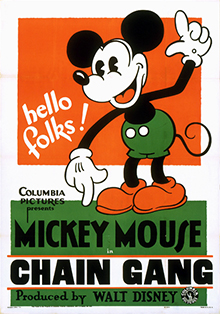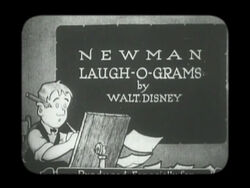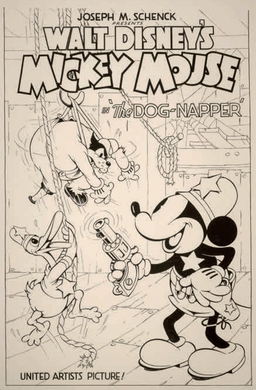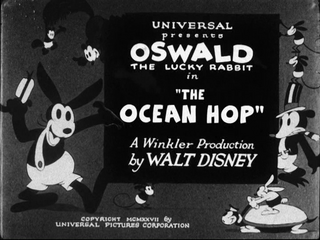
Pete is a cartoon character created by Walt Disney and Ub Iwerks of The Walt Disney Company. Pete is traditionally depicted as the villainous arch-nemesis of Mickey Mouse, and was made notorious for his repeated attempts to kidnap Minnie Mouse. Pete is the oldest continuing Disney character, having debuted in the cartoon Alice Solves the Puzzle in 1925. He originally bore the appearance of an anthropomorphic bear, but with the advent of Mickey in 1928, he was defined as a cat.

The Chain Gang is a 1930 Mickey Mouse animated film produced by Walt Disney Productions for Columbia Pictures, as part of the Mickey Mouse film series. It was the twenty-first Mickey Mouse short to be produced, the sixth of that year. It is one of a group of shorts of strikingly uneven quality produced by Disney immediately after Ub Iwerks left the studio.

Margaret J. Winkler Mintz was a key figure in silent animation history, having a crucial role to play in the histories of Max and Dave Fleischer, Pat Sullivan, Otto Messmer, and Walt Disney. She was the first woman to produce and distribute animated films. Winkler was the subject of the feature film Walt Before Mickey.

Runaway Brain is a 1995 American animated comedy horror short film produced by Walt Disney Feature Animation. Featuring Mickey Mouse and Minnie Mouse, the short centers on Mickey attempting to earn money to pay for an anniversary gift for Minnie. He responds to an advertisement to work for Doctor Frankenollie, only to find out that he is looking for a donor to switch brains with the monster he created. Featuring animation by animator Andreas Deja, it was first released in 1995 attached to North American theatrical showings of A Kid in King Arthur's Court and in 1996 attached to international theatrical showings of A Goofy Movie. It would be the final original Mickey Mouse theatrical animated short until Get a Horse! in 2013.

The Laugh-O-Gram Studio was an animation studio located on the second floor of the McConahay Building at 1127 East 31st in Kansas City, Missouri, that operated from June 28, 1921, to October 16, 1923.
Robert Fred Moore, was an American artist and animator for Walt Disney Animation Studios. Often called "Freddie," he was born and raised in Los Angeles, California. Despite limited formal art training, he rose to prominence at Disney very quickly in the early 1930s, due to his great natural talent and the tremendous appeal of his drawings. His drawings are still greatly admired by animators and animation fans.

Mickey, Donald, Goofy: The Three Musketeers is a 2004 American animated direct-to-video musical adventure film based on the film adaptations of the 1844 novel The Three Musketeers by Alexandre Dumas and the Mickey Mouse film series by Walt Disney and Ub Iwerks. As the title suggests, it features Mickey Mouse, Donald Duck, and Goofy as the three musketeers in their first full-length feature film together. This film was directed by Donovan Cook, produced by Walt Disney Pictures and the Australian office of DisneyToon Studios. It was released directly to VHS and DVD on August 17, 2004, by Walt Disney Home Entertainment, and was later re-released on Blu-ray Disc on August 12, 2014, coinciding with the film's 10th anniversary. The film received mixed to positive reviews from critics, who praised its musical numbers, action sequences and faithfulness to the original material, but were mixed on certain aspects and elements.

The Barn Dance is a Mickey Mouse short animated film first released on March 15, 1929, as part of the Mickey Mouse film series; it was the first of twelve shorts released during that year. It was directed by Walt Disney with Ub Iwerks as the head animator. The title is written as Barn Dance on the poster, while the full title is used on the title screen.

The Barnyard Battle is a Mickey Mouse short animated film first released on June 1, 1929, as part of the Mickey Mouse film series. It was the seventh Mickey Mouse short to be produced, the fourth of that year. As the title implies, it features a battle between an invading army of cats and an army of mice trying to defend their homes and farms.

Mickey's Gala Premier is a Walt Disney cartoon produced in 1933, directed by Burt Gillett, and featuring parodies of several famous Hollywood film actors from the 1930s. It was the 58th Mickey Mouse short film, and the eighth of that year.

When the Cat's Away is a Mickey Mouse short animated film first released on May 3, 1929, as part of the Mickey Mouse film series. It was directed by Walt Disney and animated by Ub Iwerks and Ben Sharpsteen. It was the sixth Mickey Mouse short to be produced, the third of that year. In this cartoon, Mickey and Minnie are the size of regular mice, and Tom Cat is the size of a person.

Once Upon a Halloween is a 2005 British animated fantasy film featuring the Evil Queen and Disney Villains. The film is an anthology that features clips from Disney animated films plus shorts and songs. While the scenes shown as flashbacks are from traditional animated films, the original scenes of the film featuring the Evil Queen with her cauldron were animated in CGI.

Building a Building is a 1933 American animated short film produced by Walt Disney Production and released by United Artists. A remake of the 1928 Oswald the Lucky Rabbit film Sky Scrappers, the cartoon depicts Mickey Mouse working at a construction site under the supervision of Peg-Leg Pete while Minnie Mouse is selling box lunches to the workers. It was directed by David Hand, his first directorial assignment at Disney, and features the voices of Walt Disney as Mickey, Marcellite Garner as Minnie, and Pinto Colvig as Pete. It was the 51st Mickey Mouse short film, and the first of that year.

The Dognapper is a 1934 animated short film produced by Walt Disney Productions and released by United Artists. The cartoon stars Mickey Mouse and Donald Duck as police officers who chase Pegleg Pete after he dognaps Fifi, Minnie Mouse's pet Pekingese. The film was directed by David Hand and features the voices of Clarence Nash as Mickey and Donald. Pinto Colvig as Pete and Melvin J. Gibby as Fifi. It was the 70th Mickey Mouse short film to be released, and the eighth of that year. This was the first and only time that Mickey was voiced by Nash; Walt was in Europe at the time and was unavailable to record his lines for Mickey, thus, Nash took over.

Get a Horse! is a 2013 American animated comedy short film produced by Walt Disney Animation Studios and directed by Lauren MacMullan. Combining black-and-white hand-drawn animation and color computer animation, the short features the characters of the late 1920s Mickey Mouse cartoons.

Julius the Cat is a fictional anthropomorphic cat created in 1922 by Walt Disney and Ub Iwerks. He first appeared in the very first animated series created by Disney, the Alice Comedies, making him the predecessor of Oswald the Lucky Rabbit and Mickey Mouse. Julius is an anthropomorphic cat, appearing intentionally similar to Felix the Cat. A bold and inventive hero, he gradually became the primary focus of the Alice Comedies, to the point Disney abandoned live action for pure animation on subsequent projects.

The Cactus Kid is a Mickey Mouse short animated film first released on May 10, 1930, as part of the Mickey Mouse film series. It was the eighteenth Mickey Mouse short to be produced, the third of that year.

Traffic Troubles is a Mickey Mouse short animated film first released on March 7, 1931, as part of the Mickey Mouse film series. It was the twenty-sixth Mickey Mouse short to be produced, and the second of that year.

The Ocean Hop is a 1927 animated short subject film, produced by Charles Mintz and George Winkler and directed by Walt Disney. The film was reissued in 1932 by Walter Lantz Productions with added music and sound effects and is the only known surviving version. The short entered the public domain on January 1, 2023.

The Fire Fighters is a Mickey Mouse short animated film first released on June 20, 1930, as part of the Mickey Mouse film series. It was the nineteenth Mickey Mouse short to be produced, the fourth of that year.



















